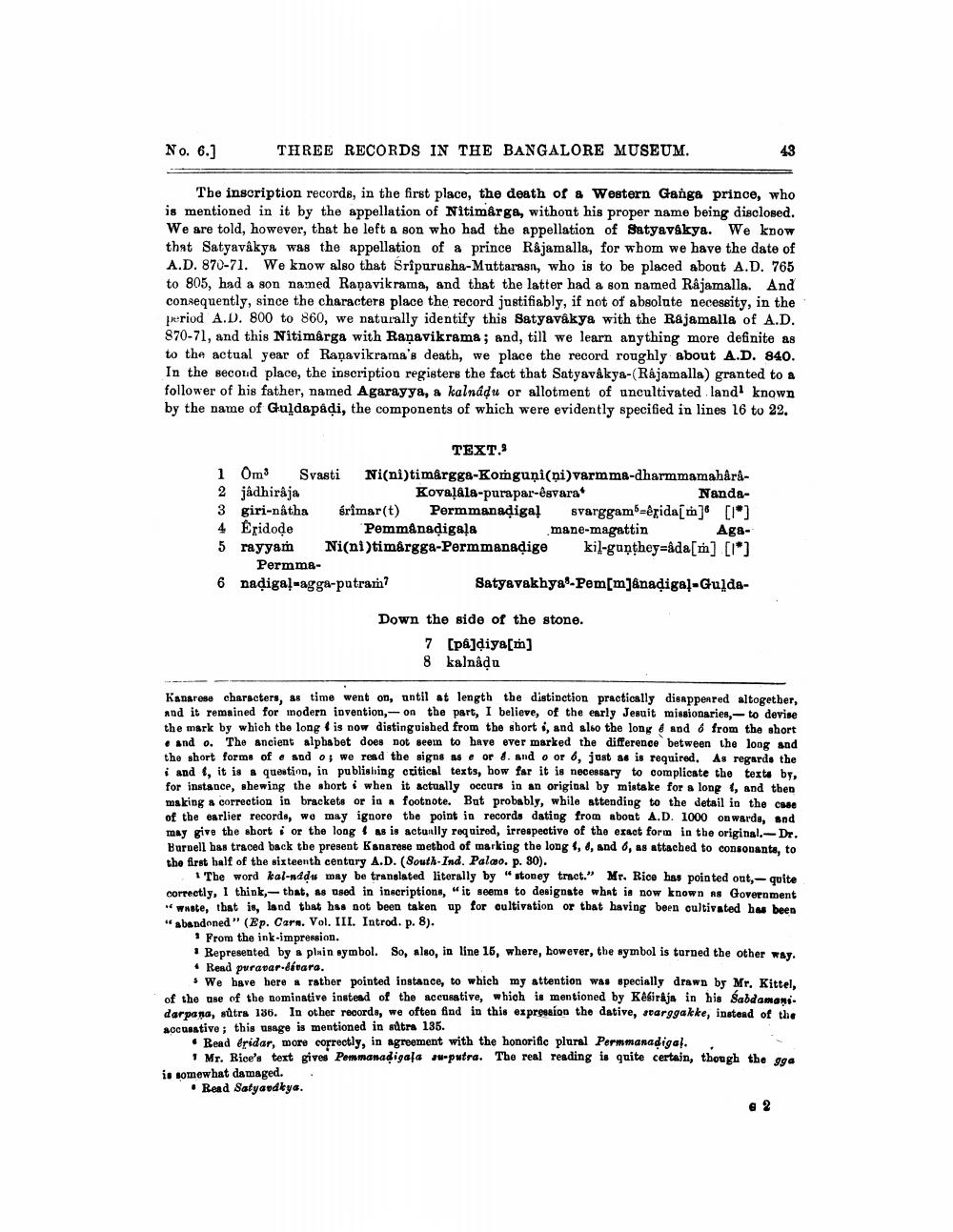________________
No. 6.]
THREE RECORDS IN THE BANGALORE MUSEUM.
Tbe inscription records, in the first place, the death of a Western Ganga prince, who is mentioned in it by the appellation of Nitimârga, without his proper name being disclosed. We are told, however, that he left a son who had the appellation of Satyavákya. We know that Satyavákya was the appellation of a prince Rajamalla, for whom we have the date of A.D. 870-71. We know also that Sripurusha-Muttarasn, who is to be placed about A.D. 765 to 805, had a son named Raņavikrama, and that the latter had a son named Rajamalla. And consequently, since the characters place the record justifiably, if not of absolute necessity, in the period A.D. 800 to 860, we naturally identify this Satyavákya with the Rajamalls of A.D. 870-71, and this Nitimarga with Raņavikrama; and, till we learn anything more definite as to the actual year of Ranavikrama's death, we place the record roughly about A.D. 840. In the second place, the inscription registers the fact that Satyavákya-(Rajamalla) granted to a follower of his father, named Agarayya, a kalnadu or allotment of uncultivated land' known by the name of Guldapadi, the components of which were evidently specified in lines 26 to 22.
TEXT. 1 Om Svasti Ni(ni)timärgga-Konguņi(ni)varmma-dharmmamahari2 jâdhiraja Kovaļala-purapar-êsvara
Nanda3 giri-natha srimar(t) Permmanadigaļ svarggam =érida[m] [18] 4 Eridode Pemmånadigaļa
mane-magattin
Ag&5 rayyam Ni(ni)timárgga-Permmanadige kil-gunthey=&da[m] [1*]
Permme6 nadigaļ-agga-putram?
Satyavakhya -Pem[m]ånadigal-Gulda
Down the side of the stone.
7 [pâ]diya[m] 8 kalnadu
Kanarese characters, as time went on, until at length the distinction practically disappeared altogether, and it remained for modern invention, - on the part, I believe, of the early Jesuit missionaries,-to devise the mark by which the long lis now distinguished from the short i, and also the long & and from the short
and o. The ancient alphabet does not seem to have ever marked the difference between the long and the short forms of and o; we read the signs as e or 8. And o or 6, just as is required. As regards the i and it is a question, in publishing critical texts, how far it is necessary to complicate the texts by, for instance, shewing the short i when it actually occurs in an original by mistake for a long , and then making a correction in brackets or in footnote. But probably, while attending to the detail in the case of the earlier recorda, wo may ignore the point in records dating from about A.D. 1000 onwards, and may give the short i or the long as is actually required, irrespective of the exact form in the original.-Dr. Burnell has traced back the present Kanarese method of marking the long , 4, and 6, as attached to consonante, to the first half of the sixteenth century A.D. (South-Ind. Palao. p. 80).
The word kal-ndd may be translated literally by "stoney tract." Mr. Rice has pointed out,- quite correctly, I think, that, as used in inscriptions, it seems to designate what is now known as Government
wuate, that is, land that has not been taken up for cultivation or that having been cultivated has been "abandoned" (Ep. Carn. Vol. III. Introd. p. 8).
. From the ink-impression.
Represented by a plain symbol. So, also, in line 15, where, however, the symbol is turned the other way. • Read puravar-dívara.
. We have here a rather pointed instance, to which my attention was specially drawn by Mr. Kittel. of the use of the nominative instead of the accusative, which is mentioned by Kesiraja in his Sabdamani. darpana, sūtra 186. In other records, we often find in this expression the dative, sarggakke, instead of the accusative; this usage is mentioned in sūtra 135.
• Read éridar, more correctly, in agreement with the honorific plural Permmanadigal. .
Mr. Rice's text gives Pemmanadigala sw-putra. The real reading is quite certain, though the gga is somewhat damaged. .
• Read Satyavdkye.




